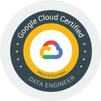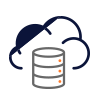
The Google Data Engineer - Professional Training course provides in-depth knowledge on designing, building, and managing data solutions using Google Cloud tools. Participants will gain hands-on experience with services like BigQuery, Cloud Pub/Sub, Dataflow, and Cloud Storage, enabling them to develop robust data pipelines, optimize data processing, and perform advanced analytics. Ideal for professionals aiming to advance their expertise in cloud data engineering, this course offers the skills to manage scalable, high-performance data systems.
Google Data Engineer - Professional Training Interview Questions Answers- For Intermediate
1. Explain the concept of data sharding and its importance in data engineering.
Data sharding is the practice of dividing a large dataset into smaller, more manageable pieces, or "shards," each stored on a different server or database. This helps to distribute the load across multiple systems, improving performance and scalability. Sharding is important because it allows data to be processed more efficiently by parallelizing queries across the shards. It is often used in big data systems like Google Bigtable and Google Cloud Spanner, where horizontal scalability is crucial for handling massive amounts of data.
2. What is Google Cloud Pub/Sub, and how does it support real-time data streaming?
Google Cloud Pub/Sub is a messaging service that facilitates asynchronous communication between systems by sending and receiving messages. It is designed for real-time event-driven applications, where it decouples senders from receivers. Pub/Sub helps in real-time data streaming by ensuring that events generated from various sources, such as IoT devices or logs, can be ingested and processed immediately without delay. It ensures that data streams are managed and processed continuously with low-latency, which is essential for real-time analytics.
3. How does Google Cloud Dataproc simplify running Hadoop and Spark workloads?
Google Cloud Dataproc is a fully managed cloud service that simplifies the process of running Hadoop and Apache Spark workloads. It allows users to quickly create clusters, process large datasets, and scale resources as needed. Dataproc manages cluster configuration, scaling, and lifecycle, so data engineers don’t need to worry about the underlying infrastructure. This integration with Google Cloud’s other services like BigQuery and Cloud Storage provides seamless data processing and analytics workflows.
4. What are the best practices for managing cost in Google BigQuery?
Managing costs in Google BigQuery can be challenging if queries are not optimized properly. Best practices include partitioning and clustering tables to reduce the amount of data scanned during queries. Using materialized views can help pre-compute results for frequent queries, reducing compute costs. It is also beneficial to use the flat-rate pricing model for predictable workloads, instead of the pay-per-query model. Additionally, monitoring query performance and setting up budgets or alerts through Google Cloud's billing tools can help manage and control costs.
5. Explain the concept of event-driven architecture and its role in Google Cloud data engineering.
Event-driven architecture (EDA) is a design paradigm where the flow of data and processes is driven by events, or changes in state, in the system. In the context of Google Cloud, EDA can be implemented using services like Cloud Pub/Sub to trigger downstream processing whenever an event occurs. This architecture is especially useful in data engineering for real-time data processing, enabling systems to react to events, such as a new data file being uploaded or a new user action. It allows for a flexible, scalable, and decoupled approach to data processing.
6. What is the role of data transformation in data pipelines?
Data transformation is the process of converting raw data into a more structured, usable form for analysis. It involves operations like filtering, aggregating, joining, or converting data formats. Data transformation is critical in data pipelines as it ensures that the data being ingested from various sources is cleaned, formatted, and optimized for analysis. In Google Cloud, tools like Cloud Dataflow or BigQuery perform these transformations in batch or real-time, ensuring the data is consistent and ready for downstream analytics or machine learning.
7. What are the differences between SQL and NoSQL databases, and when would you choose one over the other?
SQL databases are relational and use structured query language to manage data stored in tables with fixed schemas. They are ideal for applications that require complex queries and transactional consistency. NoSQL databases, on the other hand, are non-relational and are designed to handle unstructured or semi-structured data. NoSQL databases offer greater flexibility and scalability, making them ideal for large-scale applications like social media platforms or IoT systems. In data engineering, you would use SQL databases when dealing with structured data requiring complex joins and transactions, while NoSQL is preferred for large, unstructured datasets that require fast reads and scalability.
8. How do you ensure the reliability of a data pipeline in Google Cloud?
To ensure the reliability of a data pipeline in Google Cloud, several strategies can be employed. First, you can use Cloud Composer to orchestrate and schedule workflows to ensure that tasks are performed in the correct order. Using Cloud Pub/Sub for decoupling services ensures that message delivery is reliable. Implementing automatic retries for failed tasks and creating error-handling mechanisms in Dataflow or BigQuery is essential. Additionally, monitoring the pipeline using Google Cloud Monitoring and setting up alerts for failures or performance issues ensures that any problems can be detected and fixed quickly.
9. What is the role of metadata in data engineering?
Metadata is data that describes other data, providing context such as its source, format, structure, and lineage. In data engineering, metadata is crucial for organizing, managing, and understanding data at scale. It helps engineers track data flow through various stages of a pipeline, ensure data quality, and manage transformations. Google Cloud services like BigQuery provide metadata management features, which help in optimizing queries, auditing, and ensuring data compliance. By maintaining metadata, engineers can also ensure that data is used consistently and accurately across various systems.
10. How do you optimize the performance of Google Cloud Storage?
To optimize the performance of Google Cloud Storage, best practices include choosing the right storage class based on data access patterns, such as Nearline or Coldline for infrequent access. You should also organize data in buckets by regions to minimize latency and optimize for access speed. Using parallel uploads and object versioning for large datasets helps improve performance during data retrieval. Additionally, proper naming conventions and data compression techniques can enhance read/write efficiency, reducing overall costs.
11. What are the key benefits of using Google Cloud Spanner for data engineering?
Google Cloud Spanner is a fully managed, scalable, and highly available relational database that provides the consistency of SQL databases with the scalability of NoSQL databases. Its key benefits include global distribution, strong consistency, and automatic horizontal scaling without the need for complex sharding. This makes it ideal for data engineering tasks that require high availability, low-latency access, and a relational model. Spanner supports real-time analytics, multi-region replication, and can handle both transactional and analytical workloads.
12. What is a data pipeline, and why is it essential in Google Cloud?
A data pipeline is a set of processes that automate the collection, transformation, and loading (ETL) of data from various sources into a storage or analysis system. In Google Cloud, data pipelines are essential for orchestrating data workflows between services like Cloud Dataflow, BigQuery, and Cloud Pub/Sub. These pipelines ensure that data is processed efficiently and delivered in real-time or batch for analytics, reporting, or machine learning. Automating data movement through pipelines reduces manual intervention, improves data accuracy, and allows for scalable data processing.
13. What is the purpose of cloud orchestration in data engineering?
Cloud orchestration refers to the automation of tasks and workflows across multiple cloud services. In data engineering, orchestration tools like Cloud Composer and Apache Airflow help to automate the scheduling, execution, and monitoring of data processing workflows. This ensures that tasks are executed in the correct order and allows for the handling of complex dependencies. By managing workflows, orchestration tools improve operational efficiency, ensure data consistency, and make it easier to scale data pipelines across cloud environments.
14. How do you ensure data quality in Google Cloud?
Ensuring data quality in Google Cloud involves several practices, including validating data at each stage of the ETL pipeline using data validation frameworks. You can set up Google Cloud DLP (Data Loss Prevention) to monitor and protect sensitive data. Implementing data profiling and quality checks within Cloud Dataflow ensures that transformations meet defined standards. Regularly running data consistency checks in BigQuery ensures that the data being analyzed is accurate and reliable. Additionally, maintaining metadata for lineage tracking helps detect issues early in the pipeline.
15. What is the significance of using Apache Kafka in a data pipeline?
Apache Kafka is a distributed event streaming platform that enables real-time data ingestion and processing. In a data pipeline, Kafka is used to handle high-throughput, low-latency messaging between systems, making it ideal for real-time analytics and event-driven architectures. It helps in managing streams of data by decoupling producers and consumers of data, ensuring that data is reliably ingested, processed, and analyzed. Kafka is often used in conjunction with other tools like Google Cloud Pub/Sub for managing data streams at scale, ensuring high availability and durability for real-time data pipelines.
Google Data Engineer - Professional Training Interview Questions Answers- For Advanced
1. What is the role of Google Cloud Pub/Sub in stream processing, and how does it integrate with other services?
Google Cloud Pub/Sub is a fully managed messaging service that facilitates real-time, asynchronous communication between applications. It is an essential component for stream processing as it enables the ingestion of large volumes of real-time data. Pub/Sub decouples data producers from consumers, allowing applications to send and receive messages without direct connections. It integrates seamlessly with Google Cloud Dataflow, where data from Pub/Sub can be processed in real-time, and with BigQuery for real-time analytics. This integration ensures that event-driven architectures can process streaming data and provide timely insights across multiple systems, whether through real-time dashboards or machine learning models.
2. How would you optimize the performance of large-scale data pipelines on Google Cloud?
Optimizing the performance of large-scale data pipelines in Google Cloud involves a multi-faceted approach. First, data should be partitioned and clustered appropriately in BigQuery to reduce the amount of data scanned by queries. Partitioning tables based on time-based fields or frequently filtered columns improves efficiency. Second, using Google Cloud Dataflow, which automatically scales resources based on the volume of incoming data, helps reduce latency in real-time processing. Additionally, using Cloud Composer to orchestrate workflows and Apache Airflow to schedule tasks ensures smooth execution of complex, multi-step data pipelines. Monitoring resource utilization, optimizing joins, and using materialized views for frequently queried data also enhance performance by reducing query execution time.
3. What is Google Cloud Dataproc, and how does it facilitate big data processing?
Google Cloud Dataproc is a fully managed cloud service for running Apache Hadoop, Apache Spark, and Apache Hive workloads. It provides a flexible and scalable environment for processing large datasets, especially for batch data processing jobs. Dataproc integrates with Google Cloud Storage for scalable data storage and can work seamlessly with BigQuery for post-processing and analytics. The service simplifies the management of Hadoop and Spark clusters, automatically provisioning resources, scaling clusters based on workload demands, and performing task management. It is well-suited for data engineers who need to perform distributed data processing without managing the underlying infrastructure, which allows them to focus on data transformation and analytics.
4. How do you ensure that data in Google Cloud is properly secured?
Ensuring data security in Google Cloud involves a combination of encryption, access control, and monitoring. Encryption is enabled by default for data at rest and in transit, using Google’s robust encryption methods. For access control, Identity and Access Management (IAM) is used to grant roles and permissions at various levels, such as for specific users or services accessing Google Cloud resources. This ensures that only authorized entities can access sensitive data. Additionally, VPC Service Controls can be set up to create security perimeters, protecting resources from data exfiltration. Regular monitoring using Cloud Security Command Center and Google Cloud Audit Logs helps identify potential vulnerabilities and track unauthorized access. For sensitive data, services like Google Cloud Data Loss Prevention (DLP) API can help identify and mask personally identifiable information (PII).
5. What are the best practices for designing data pipelines in Google Cloud?
Designing data pipelines in Google Cloud requires best practices that ensure scalability, reliability, and efficiency. Key practices include:
- Using serverless tools: Leverage fully managed services like Google Cloud Dataflow, BigQuery, and Cloud Pub/Sub to reduce infrastructure management and improve scalability.
- Data partitioning and clustering: Use BigQuery’s partitioned tables and clustering to improve query performance by reducing the amount of data that needs to be scanned.
- Automation and orchestration: Utilize Cloud Composer to automate and schedule workflows, and ensure that tasks are executed in the correct order with proper dependency management.
- Monitoring and logging: Set up robust monitoring using Google Cloud Monitoring and Cloud Logging to track the health and performance of pipelines.
- Data quality checks: Implement validation and error handling at various stages of the pipeline to ensure that data is consistent and accurate.
6. What is the significance of Cloud Spanner in Google Cloud's data infrastructure?
Google Cloud Spanner is a globally distributed, relational database service that offers horizontal scalability while maintaining strong consistency and high availability. It is unique because it combines the benefits of traditional SQL databases with the scalability of NoSQL databases. Spanner supports ACID transactions, which ensures data consistency, while also allowing for the distribution of data across regions without compromising performance. This makes it ideal for applications that require multi-region replication, low-latency access to relational data, and high availability. Spanner is often used for mission-critical, global applications, such as financial services or e-commerce platforms, that require both consistency and scalability.
7. How would you handle and process semi-structured data in Google Cloud?
Handling semi-structured data, such as JSON, XML, or Avro, in Google Cloud can be done efficiently using tools like BigQuery, Cloud Dataflow, and Cloud Dataproc. BigQuery natively supports querying JSON and Avro data, allowing you to load semi-structured data into tables with nested and repeated fields. In Cloud Dataflow, semi-structured data can be processed using Apache Beam transformations to clean, parse, and convert the data into a more structured format before loading it into a data warehouse or storage system. Cloud Dataproc can also be used for more complex transformations and big data processing tasks, including the use of Apache Hive or Spark to process semi-structured data at scale. Google’s metadata management tools, like Cloud Data Catalog, can help track the data schema and make it easier to manage evolving formats.
8. What are materialized views, and how do they improve query performance in BigQuery?
Materialized views are precomputed views in BigQuery that store the results of a query, which are periodically updated as new data is added or existing data changes. They significantly improve query performance by eliminating the need to re-run expensive queries, particularly those that aggregate large datasets. When a query is executed against a materialized view, it retrieves the precomputed results instead of scanning the underlying table, which reduces the processing time and cost. Materialized views are particularly useful for frequently queried reports or data aggregations, as they provide an efficient way to store and access summary data.
9. How do you approach schema design and optimization for large datasets in Google Cloud?
When designing schemas for large datasets in Google Cloud, several strategies can be employed:
- Partitioning: Use partitioned tables in BigQuery based on common filtering criteria, such as date or region. This reduces the amount of data scanned during queries, improving performance and cost-efficiency.
- Clustering: Apply clustering to organize data by frequently queried columns, which speeds up data retrieval by allowing BigQuery to skip over irrelevant data during scans.
- Normalization and Denormalization: While normalized schemas reduce data redundancy, denormalization is often preferred in large datasets for performance optimization. BigQuery is designed to handle denormalized structures efficiently, particularly with nested and repeated fields.
- Efficient Data Types: Use the most appropriate data types for each field to minimize storage costs and improve processing performance. For example, integer or float types are more efficient than using strings for numeric values.
10. How does Google Cloud Data Catalog assist in managing metadata, and why is it important?
Google Cloud Data Catalog is a fully managed metadata management service that helps data engineers and scientists organize and discover data assets across Google Cloud services. It allows users to create a centralized repository for metadata, making it easier to understand the structure, lineage, and usage of data. Data Catalog is essential for ensuring data governance, as it enables tracking of data flow and transformations through the pipeline. By providing tools for managing data discovery, ensuring consistency, and improving collaboration, Data Catalog helps in reducing redundant data processing, improving data quality, and meeting compliance standards. Additionally, it integrates with other Google Cloud services like BigQuery and Cloud Pub/Sub, helping to centralize metadata management.
11. What is the role of Google Cloud Dataflow in building real-time data pipelines?
Google Cloud Dataflow is a fully managed service that is ideal for building both real-time and batch data pipelines. In real-time data processing, Dataflow leverages Apache Beam’s programming model to process streaming data as it arrives, allowing for continuous ingestion, transformation, and analysis. It can be used to process data from various sources such as Cloud Pub/Sub, Cloud Storage, or external APIs. The service automatically scales based on data volume, managing resources dynamically, which is crucial for real-time data processing where high throughput and low latency are required. Additionally, Dataflow integrates with other Google Cloud services like BigQuery for analysis and Cloud Machine Learning Engine for real-time predictions.
12. What are the key differences between batch and stream processing in Google Cloud, and when would you choose one over the other?
The key difference between batch processing and stream processing lies in the way data is processed. Batch processing handles large volumes of data in fixed intervals, such as hourly or daily, and is well-suited for tasks that do not require real-time updates, such as generating reports or running complex analytics. Google Cloud’s BigQuery is optimized for batch processing, providing fast querying of large datasets.
Stream processing, on the other hand, processes data continuously as it arrives in real-time, allowing for low-latency analysis and decision-making. This is ideal for use cases like fraud detection, IoT sensor data analysis, or monitoring systems. Google Cloud Dataflow and Cloud Pub/Sub are often used for stream processing, where data is ingested and processed immediately as it is generated. The choice between batch and stream processing depends on the specific requirements of the use case, with stream processing being preferable for real-time applications and batch processing being used for large-scale data analysis.
13. How do you manage data consistency across distributed data sources in Google Cloud?
Data consistency across distributed data sources in Google Cloud can be achieved by employing eventual consistency or strong consistency models depending on the use case. Cloud Spanner is an excellent choice for applications that require strong consistency and transactional guarantees across distributed systems. For less critical systems, BigQuery and Bigtable offer eventual consistency, which allows data to eventually converge to a consistent state.
To manage data consistency, it’s important to implement strategies like data validation, versioning, and data reconciliation. Using Cloud Pub/Sub for event-driven architecture can ensure that updates to distributed data sources are propagated correctly. Additionally, setting up transactional workflows in Dataflow ensures that data transformations are consistent and applied atomically across distributed systems.
14. What are the trade-offs of using serverless data processing services like Dataflow and BigQuery?
The primary advantage of using serverless data processing services like Dataflow and BigQuery is the reduction of infrastructure management overhead. These services automatically scale based on data volume, meaning users only pay for the resources they consume, which provides flexibility and cost-efficiency. Additionally, they handle complex operational tasks like provisioning, patching, and monitoring, allowing data engineers to focus on business logic and data processing.
However, the trade-off lies in control over performance and customization. Serverless services abstract much of the underlying infrastructure, making it harder to fine-tune performance or optimize certain aspects of resource allocation. While these services are highly scalable, they may not be as suitable for applications requiring ultra-low-latency or specialized optimizations that can be achieved with dedicated infrastructure. Furthermore, serverless offerings might have higher per-query or per-task costs when compared to traditional, fixed-infrastructure solutions, especially for high-volume, high-complexity workloads.
15. What is the role of Cloud Composer in orchestrating data workflows, and how does it integrate with other Google Cloud services?
Cloud Composer is a fully managed Apache Airflow service that is used to orchestrate, schedule, and monitor complex workflows across multiple Google Cloud services. It enables the automation of tasks, such as data ingestion, transformation, and loading, in a data pipeline. Cloud Composer integrates with BigQuery, Cloud Dataflow, Cloud Storage, Cloud Pub/Sub, and other services, allowing data engineers to define workflows that span across different components of Google Cloud. The platform helps track task dependencies, manage retries, and provide centralized logging, ensuring that workflows run smoothly. It is essential for managing multi-step data processes, handling failures, and ensuring that the pipeline operates without manual intervention.
Course Schedule
| Apr, 2025 | Weekdays | Mon-Fri | Enquire Now |
| Weekend | Sat-Sun | Enquire Now | |
| May, 2025 | Weekdays | Mon-Fri | Enquire Now |
| Weekend | Sat-Sun | Enquire Now |
Related Courses
Related Articles
Related Interview
Related FAQ's
- Instructor-led Live Online Interactive Training
- Project Based Customized Learning
- Fast Track Training Program
- Self-paced learning
- In one-on-one training, you have the flexibility to choose the days, timings, and duration according to your preferences.
- We create a personalized training calendar based on your chosen schedule.
- Complete Live Online Interactive Training of the Course
- After Training Recorded Videos
- Session-wise Learning Material and notes for lifetime
- Practical & Assignments exercises
- Global Course Completion Certificate
- 24x7 after Training Support












 Join our Live Instructor-Led online classes delivered by industry experts
Join our Live Instructor-Led online classes delivered by industry experts